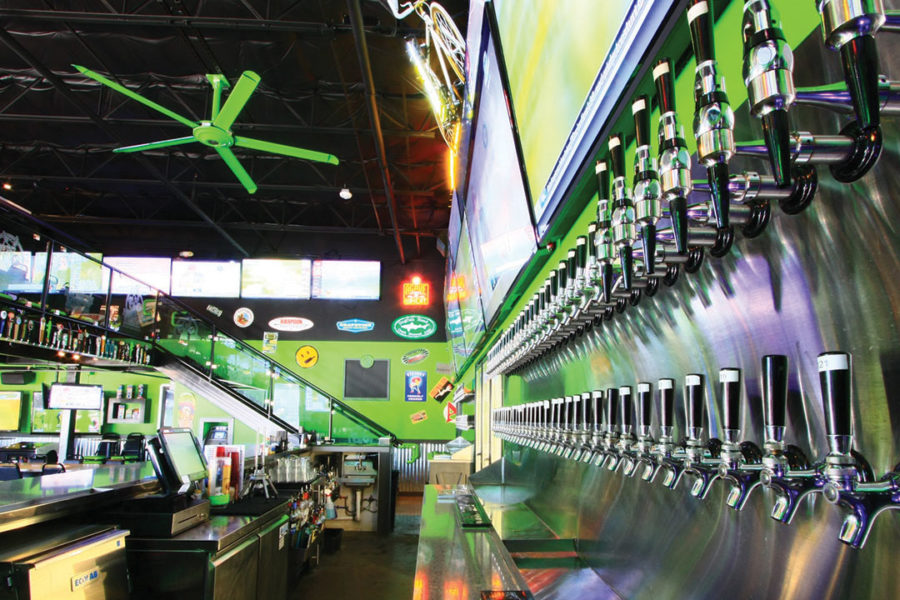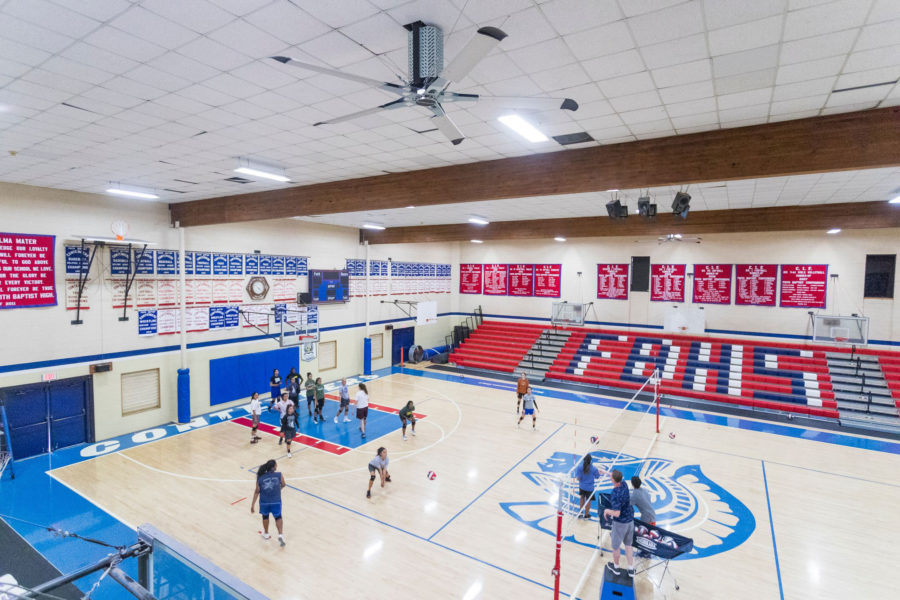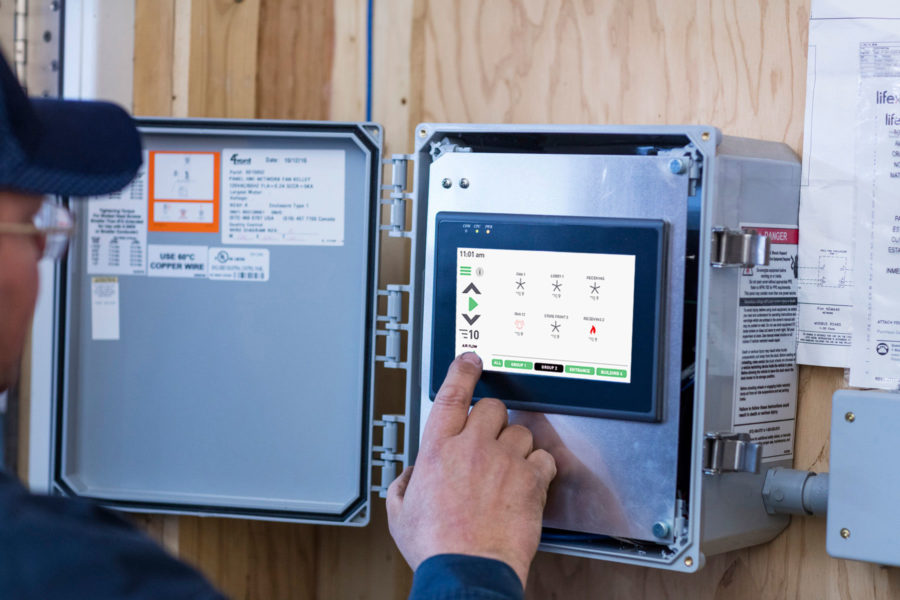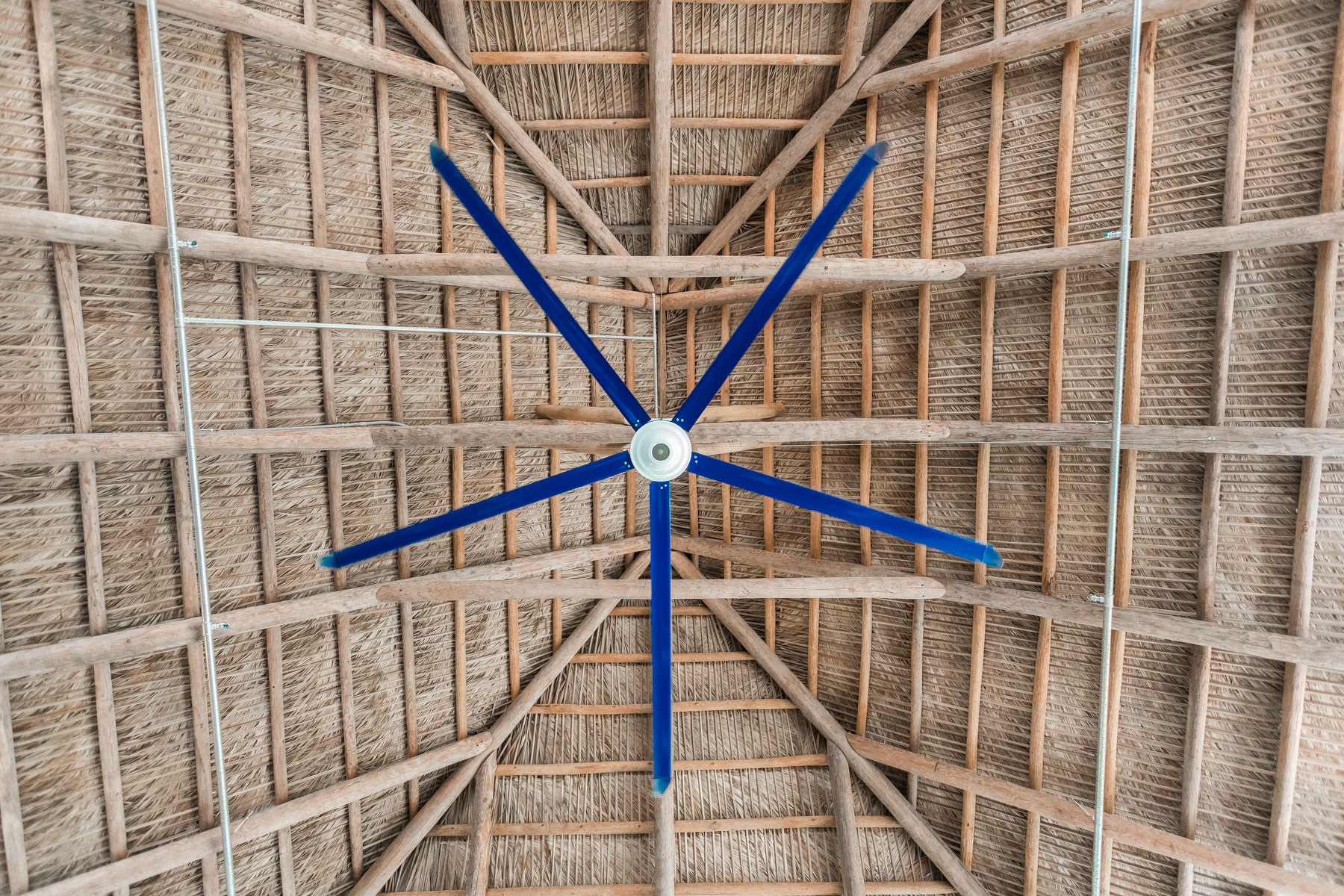Story at a glance:
- Designing with HVLS fans allows for better air control systems and increased comfort.
- Developed first to cool dairy cattle, fans are now engineered to be smart and sleek, efficiently moving the air within all types of environments.
- Depending on your goals, there are a variety of performance maximizing fans to fit the airflow needs of commercial or residential spaces.
From dairy cattle in barns to employees in warehouses to students in classrooms, the HVLS fans of today are everywhere—and for good reason. More and more projects are designing spaces with HVLS (aka high-volume, low-speed) fans, as people turn to them for everything from occupant comfort to general airflow.
“There are not many industries anymore where these don’t exist or where they have not been applied by architects or engineers,” says Dan Linder, who’s been in the industry for more than 15 years, now as sales manager at EPIC Fans.

Photo courtesy of EPIC Fans
As the demand for HVLS fans has evolved so, too, has the technology. Linder has seen that evolution firsthand at EPIC, an engineering leader whose solutions include loading dock products, industrial and commercial doors, high-performance doors, and entrance automation. “We expanded into HVLS fans after seeing our warehouse customers’ need for better control over their air systems,” Linder says. “Our engineers set out to create a better, more efficient fan that would make airflow easier to control and save on energy costs.”
Using high-volume, low-speed technology, EPIC engineers built the first iteration of the company’s Colossus industrial fan. “Since then EPIC has improved the aerodynamics with patent-pending design features and added sophisticated touchscreen controls and networking software solutions like iFAN for even greater efficiency. As our customers have clamored for even more options, we developed a quieter, sleeker version for commercial use: the Apex model. EPIC continues to leverage our significant experience with customers of all industries as we advance fan performance and controls.”
The Evolution
HVLS fans were first developed to cool dairy cattle in California. “A hot and bothered cow produces less milk,” Linder laughs. With more airflow, cows felt more comfortable, and milk production increased. “So these fans go to dairies across the world, but then this morphed into people comfort.”
Employees working in hot warehouses also benefited, and as you might imagine, so did production. Today we’re seeing more and more businesses turn to HVLS fans for help in supplementing traditional HVAC, moving around conditioned air in warehouses, manufacturing, and even schools.
“It went from targeting one or two industries to now all of these different style applications—putting in HVLS fans to help move the air within the environment.”
Today’s Technology

EPIC Fans are manufactured by 4Front Engineered solutions, who also manufactures HVLS fans under the Kelley and Serco Brand. Photo courtesy of EPIC Fans
Today there are many HVLS fan manufacturers in the green building arena, but one big differentiator between them are their controls. “How can we make the controls automated, make them smart, and allow the building engineers or the customers to gain the benefit of their investment?” Linder says.
He points to the large warehouse example, where you have many employees—all with different temperature preferences—working on the floor. Allowing complete access to the fans when you have a lot of employees can be a nightmare, and continually changing the speed of the fans prohibits it from doing its best work.
EPIC’s solutions include controls that allow you to automate for the best environment for both occupant comfort and air quality, with temperature sensors that speed the fans up or slow them down depending on set points. You can do the same with humidity. You can also lock the master control stations in a control room or supervisor’s office for added security.
With EPIC’s iFAN you have a lot more flexibility in design, too. While 10 years ago most manufacturers offered an option with a simple on/off switch and a 1 to 10 speed knob, today’s fans offer a lot more opportunity for user control. Linder says they’re also easier to integrate into building management systems, which allows them to be used in conjunction with other equipment—be that exhaust fans, HVAC systems, heaters, or a variety of other options depending on the functionality of the facility. “The controls evolution ensures the person who has the fan is able to realize the benefits of the fan,” he says.
Air Quality

An EPIC fan is seen here in Faith Baptist Gym. HVLS fans help improve indoor air quality while keeping spaces comfortable. Photo courtesy of EPIC Fans
Linder says the best air quality happens when you properly exchange the air, but in doing so properly filter the air with either the proper-rated filters.
“Right now we are in a time when everybody’s very concerned about air quality inside buildings,” he says. And while many companies are jumping in to say they offer technology to clean the air, architects should really be considering the complete package. And Linder says HVLS fans are an important part of that package.
“Fans are moving air within the environment. That’s the reality. We don’t bring air in or exhaust air out,” he says. “One of the big conversations now is: How do we properly clean and have a better interior quality? That all comes into the air you’re bringing into a space.”
But it’s not just about bringing air in, he says. It’s also how fast that air moves and how it circulates. “We’re taking in clean air and distributing it much faster. It’s getting to people faster and throughout the space faster because of how much air the fans move,” Linder says. “It’s basically a big blender of air, distributing the clean air, and then something has to exhaust it out.”
He says HVLS fans are a piece of a really large equation to bring safe and clean air to buildings. “HVLS fans will help eliminate air stagnancy if properly applied in applications, so when using with other air movement equipment, we help those systems become more efficient. Different applications have different requirements for air turnover, air exchanges, and the amount of fresh air to be brought into the buildings and exhausted out and the fans assist with moving the air within the building.”
EPIC’s Apex fan has a five-blade design and downturned winglets that promote airflow efficiency, funneling away turbulent air that can cause drag. It’s also designed to be so quiet you probably won’t even notice it—unless, of course, the architect wants you to, as APEX comes with many color and design options. It can be designed to blend in or stand out, and its integrated electronics and wired touch screen remote functional allow for easy operation, too.
Choosing the Best Fan

Photo courtesy of EPIC Fans
When it comes to school settings like classrooms or even libraries with air conditioned air, Linder says you want a consistent airflow at a low sound level. “The Apex gives you an aesthetic look up to 14 feet where you can modify color easily at no extra cost. But if want to go more industrial and still want quiet, you’ve got Summit—our direct drive fan that will provide you with subtle airflow or maximum airflow that could blow papers off desks. It comes with an industrial look.”
While EPIC offers the options to get you whatever look and feel you want, Linder says it’s important to consider the real goal. Then ask yourself: What are the dimensions of the space? Will the fans be installed in the entire building or just sections of the building? Is the roof sloped? EPIC offers up an easy to follow HVLS application guide that suggests these questions and more before choosing a fan.
EPIC’s commercial fan, Apex, uses a gearless direct drive AC motor for premium efficiency, low dBA level, high-end design features, and a color package. Some application examples are restaurants, bars, car showrooms, schools, office environments, airport terminals, and many other conditioned spaces. Their industrial fan uses an AC induction premium IE3 motor with a gearbox. It’s great in warehouses, gyms, maintenance shops, aquatic facilities, dairy barns, agricultural buildings, and any other space that needs a large volume of air moved. And the direct drive fan uses a DC brushless premium efficiency motor that maximizes performance along with decreasing dBA levels. It can be applied in both commercial and industrial applications.
The most common issue Linder sees is misuse, or misapplication, of fans. “It’s important to understand the goal you’re trying to accomplish within the project and then select your fan, not selecting your fan based on appearance and then fitting it into an application that won’t work,” he says.




